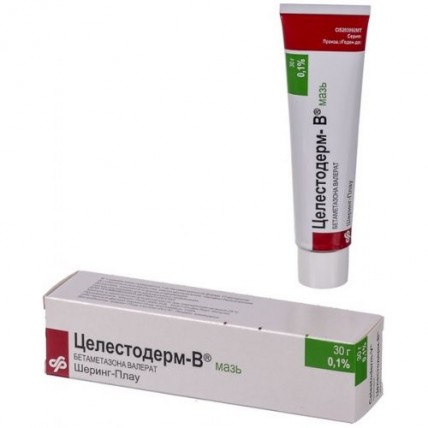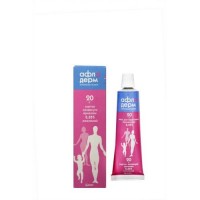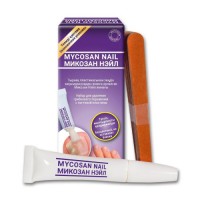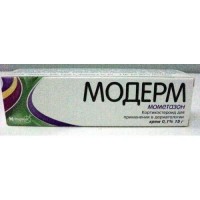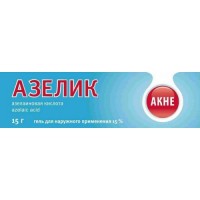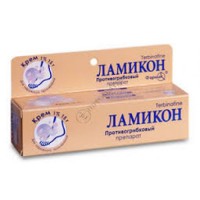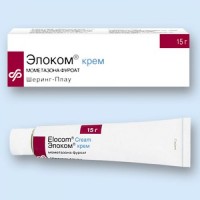Celestoderm-B 0.1% 30g ointment tube
- $22.60
Out Of Stock
The instruction
for medical use
of Tselestoderm medicine-В®
the Trade name
of Tselestoderm-B®
the International unlicensed
name Betamethasone Dosage Form Ointment of 30 G Structure of 1 G of Ointment contains
active agent - betamethasone 17 valerate (1.00 mg of betamethasone are equivalent) 1.22 mg
excipients: liquid paraffin, paraffin white soft
the Description
Soft, uniform, white ointment, without visible mechanical inclusions.
Pharmacotherapeutic group
Glucocorticosteroids for topical treatment of diseases of skin. Glucocorticosteroids, active (group III). Betamethasone.
The ATX D07AC01 code
the Pharmacological
Pharmacokinetics Data properties about pharmacokinetics of the drug Tselestoderm-B® are absent.
The pharmacodynamics
of Tselestoderm-B® has anti-inflammatory, antipruritic and vasoconstrictive effect. Betamethasone slows down release of cytokines and mediators of inflammation, reduces metabolism of arachidonic acid, initiates formation of the lipokortin having antiedematous activity, reduces permeability of vessels.
Indications
- inflammatory manifestations at the dermatosis sensitive to corticosteroid therapy
- eczema (atopic, children's, monetovidny)
- contact dermatitis
- seborrheal dermatitis
- neurodermatitis
- solar dermatitis
- exfoliative dermatitis
- stagnant dermatitis
- radiation dermatitis
- intertriginozny dermatitis
- psoriasis
- an anogenitalny and senile itching
apply the Route of administration and doses of Tselestoderm-B® with a thin layer on affected areas of skin of 1 - 3 time a day, depending on weight of a state. In most cases for achievement of effect it is enough to put 1 - 2 time a day. Frequency of putting drug is determined according to extent of defeat. At easy degree the defeats drug can be inflicted once a day, in case of more severe defeats the frequency of putting drug needs to be increased.
Duration of a course of treatment is determined by the doctor depending on weight and a course of the disease.
The route of administration at children matches that at adults (see sections of Contraindication and Special Instructions).
Side effects
- burning, an itching, irritation and xeroderma
- a folliculitis
- a hypertrichosis
- ugrepodobny rashes
- hypopigmentation
- perioral dermatitis
- allergic contact dermatitis
- maceration of skin
- consecutive infection
- an atrophy of skin, a striya, a heat rash
Side effects at children
- function oppression gipotalamo - a hypophysial and adrenal system
- Cushing's syndrome
- a growth inhibition
- lag in a weight increase
- the increase in intracranial pressure which is shown protrusion of a fontanel, a headache, bilateral hypostasis of disks of optic nerves (papillary stasis sign)
of the Contraindication
- hypersensitivity to any component of drug
- children's age up to 6 months
Medicinal interactions
is not revealed
Special instructions
If at use of drug the irritation or hypersensitivity is noted, treatment the patient should stop and pick up other therapy.
In the presence of an infection it is necessary to appoint antifungal or antibacterial agents, respectively. If at the same time the desirable effect does not occur quickly, use of corticosteroids needs to be stopped before elimination of symptoms of an infection.
Any by-effects which meet at system use of glucocorticoids including suppression of bark of adrenal glands, can arise also at their topical administration, especially at babies and children.
System absorption of local corticosteroids can increase at their use for a long time, at treatment of a big body surface or when using occlusive bandages. At babies and children the system absorption of local glucocorticosteroids at their prolonged use can increase, at treatment of extensive body surfaces or when using of the closing bandages. It is necessary to adhere to the appropriate measures of precaution in such cases or at prolonged use, especially at treatment of babies and children.
Drug is not intended for use in ophthalmology.
Use in pediatrics
Children can be more susceptible to action of the local glucocorticosteroids causing oppression gipotalamo - a hypophysial and adrenal system, than patients of advanced age. It is connected with higher absorption of drug at children owing to the bigger size of a ratio of surface area and body weight. Oppression of an adrenal
system can be shown in the low level of cortisol in blood plasma and lack of the response to therapy by adrenocorticotropic hormones.
Ointment cannot be applied with an occlusive bandage.
Pregnancy and the period of a lactation
Safety of use of local glucocorticosteroids for pregnant women is not proved. Appointment of this group of drugs during pregnancy is justified only if the potential advantage for the woman exceeds potential risk for a fruit. During pregnancy, drugs of this group should not be used in high doses or it is long.
It is not known whether can lead topical administration of corticosteroids through system absorption to emergence them in mother's milk. The decision on the termination of breastfeeding or drug withdrawal should be accepted taking into account need of use of drug for mother.
Features of influence of medicine on ability to run the vehicle or potentially dangerous mechanisms
Drug does not affect ability to run vehicles or difficult technical devices.
Overdose
Symptoms. Excessive or prolonged use of local glucocorticosteroids can cause oppression of hypophysial and adrenal function that there can be the reason of development of secondary insufficiency of bark of adrenal glands and emergence of symptoms of a hypercorticoidism, including Cushing's syndrome.
Treatment: Symptomatic treatment. If necessary correction of an electrolytic imbalance is shown. In case of chronic toxic action the gradual cancellation of glucocorticosteroids is recommended.
The form of release and packing
On 30 g of drug place in tubas aluminum, with internal varnish coating and with the screwing-up plastic kovpachok, with a pin for piercing of a membrane.
On 1 tuba together with the instruction for medical use in the state and Russian languages place in a pack from cardboard.
To Store storage conditions at a temperature not above 25 °C
to Store out of children's reach!
A period of storage
3 years
not to use drug after expiry date.
Prescription status
According to the prescription
Shering-Plau Labo Producer H. B., Belgium
the Owner of the registration certificate
Shering-Plau Sentral East AG, Switzerland
the Address of the organization accepting in the territory of the Republic of Kazakhstan claims of consumers on quality of products (goods): Representative office of Shering-Plau Sentral East AG in Kazakhstan, Almaty, Dostyk Ave., 38, business center Ken Dala, the 5th floor
Ph. +7 (727) 330-42-66, +7 (727) 259-80-84
Fax +7 (727) 259-80-90
e-mail: dpoccis2@merck.com, pharmacovigilance.ukraine&cis@merck.com
for medical use
of Tselestoderm medicine-В®
the Trade name
of Tselestoderm-B®
the International unlicensed
name Betamethasone Dosage Form Ointment of 30 G Structure of 1 G of Ointment contains
active agent - betamethasone 17 valerate (1.00 mg of betamethasone are equivalent) 1.22 mg
excipients: liquid paraffin, paraffin white soft
the Description
Soft, uniform, white ointment, without visible mechanical inclusions.
Pharmacotherapeutic group
Glucocorticosteroids for topical treatment of diseases of skin. Glucocorticosteroids, active (group III). Betamethasone.
The ATX D07AC01 code
the Pharmacological
Pharmacokinetics Data properties about pharmacokinetics of the drug Tselestoderm-B® are absent.
The pharmacodynamics
of Tselestoderm-B® has anti-inflammatory, antipruritic and vasoconstrictive effect. Betamethasone slows down release of cytokines and mediators of inflammation, reduces metabolism of arachidonic acid, initiates formation of the lipokortin having antiedematous activity, reduces permeability of vessels.
Indications
- inflammatory manifestations at the dermatosis sensitive to corticosteroid therapy
- eczema (atopic, children's, monetovidny)
- contact dermatitis
- seborrheal dermatitis
- neurodermatitis
- solar dermatitis
- exfoliative dermatitis
- stagnant dermatitis
- radiation dermatitis
- intertriginozny dermatitis
- psoriasis
- an anogenitalny and senile itching
apply the Route of administration and doses of Tselestoderm-B® with a thin layer on affected areas of skin of 1 - 3 time a day, depending on weight of a state. In most cases for achievement of effect it is enough to put 1 - 2 time a day. Frequency of putting drug is determined according to extent of defeat. At easy degree the defeats drug can be inflicted once a day, in case of more severe defeats the frequency of putting drug needs to be increased.
Duration of a course of treatment is determined by the doctor depending on weight and a course of the disease.
The route of administration at children matches that at adults (see sections of Contraindication and Special Instructions).
Side effects
- burning, an itching, irritation and xeroderma
- a folliculitis
- a hypertrichosis
- ugrepodobny rashes
- hypopigmentation
- perioral dermatitis
- allergic contact dermatitis
- maceration of skin
- consecutive infection
- an atrophy of skin, a striya, a heat rash
Side effects at children
- function oppression gipotalamo - a hypophysial and adrenal system
- Cushing's syndrome
- a growth inhibition
- lag in a weight increase
- the increase in intracranial pressure which is shown protrusion of a fontanel, a headache, bilateral hypostasis of disks of optic nerves (papillary stasis sign)
of the Contraindication
- hypersensitivity to any component of drug
- children's age up to 6 months
Medicinal interactions
is not revealed
Special instructions
If at use of drug the irritation or hypersensitivity is noted, treatment the patient should stop and pick up other therapy.
In the presence of an infection it is necessary to appoint antifungal or antibacterial agents, respectively. If at the same time the desirable effect does not occur quickly, use of corticosteroids needs to be stopped before elimination of symptoms of an infection.
Any by-effects which meet at system use of glucocorticoids including suppression of bark of adrenal glands, can arise also at their topical administration, especially at babies and children.
System absorption of local corticosteroids can increase at their use for a long time, at treatment of a big body surface or when using occlusive bandages. At babies and children the system absorption of local glucocorticosteroids at their prolonged use can increase, at treatment of extensive body surfaces or when using of the closing bandages. It is necessary to adhere to the appropriate measures of precaution in such cases or at prolonged use, especially at treatment of babies and children.
Drug is not intended for use in ophthalmology.
Use in pediatrics
Children can be more susceptible to action of the local glucocorticosteroids causing oppression gipotalamo - a hypophysial and adrenal system, than patients of advanced age. It is connected with higher absorption of drug at children owing to the bigger size of a ratio of surface area and body weight. Oppression of an adrenal
system can be shown in the low level of cortisol in blood plasma and lack of the response to therapy by adrenocorticotropic hormones.
Ointment cannot be applied with an occlusive bandage.
Pregnancy and the period of a lactation
Safety of use of local glucocorticosteroids for pregnant women is not proved. Appointment of this group of drugs during pregnancy is justified only if the potential advantage for the woman exceeds potential risk for a fruit. During pregnancy, drugs of this group should not be used in high doses or it is long.
It is not known whether can lead topical administration of corticosteroids through system absorption to emergence them in mother's milk. The decision on the termination of breastfeeding or drug withdrawal should be accepted taking into account need of use of drug for mother.
Features of influence of medicine on ability to run the vehicle or potentially dangerous mechanisms
Drug does not affect ability to run vehicles or difficult technical devices.
Overdose
Symptoms. Excessive or prolonged use of local glucocorticosteroids can cause oppression of hypophysial and adrenal function that there can be the reason of development of secondary insufficiency of bark of adrenal glands and emergence of symptoms of a hypercorticoidism, including Cushing's syndrome.
Treatment: Symptomatic treatment. If necessary correction of an electrolytic imbalance is shown. In case of chronic toxic action the gradual cancellation of glucocorticosteroids is recommended.
The form of release and packing
On 30 g of drug place in tubas aluminum, with internal varnish coating and with the screwing-up plastic kovpachok, with a pin for piercing of a membrane.
On 1 tuba together with the instruction for medical use in the state and Russian languages place in a pack from cardboard.
To Store storage conditions at a temperature not above 25 °C
to Store out of children's reach!
A period of storage
3 years
not to use drug after expiry date.
Prescription status
According to the prescription
Shering-Plau Labo Producer H. B., Belgium
the Owner of the registration certificate
Shering-Plau Sentral East AG, Switzerland
the Address of the organization accepting in the territory of the Republic of Kazakhstan claims of consumers on quality of products (goods): Representative office of Shering-Plau Sentral East AG in Kazakhstan, Almaty, Dostyk Ave., 38, business center Ken Dala, the 5th floor
Ph. +7 (727) 330-42-66, +7 (727) 259-80-84
Fax +7 (727) 259-80-90
e-mail: dpoccis2@merck.com, pharmacovigilance.ukraine&cis@merck.com
